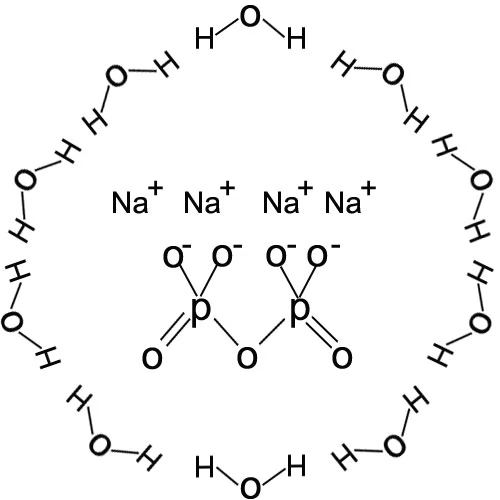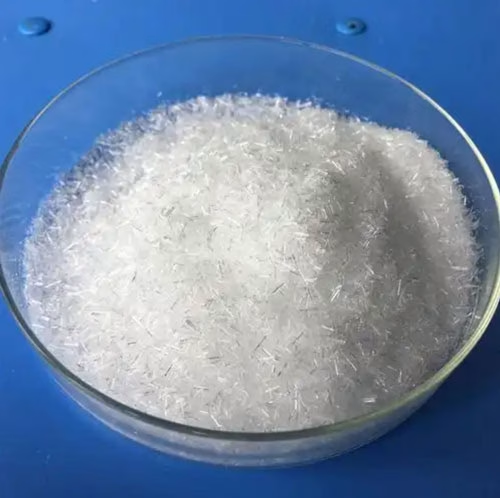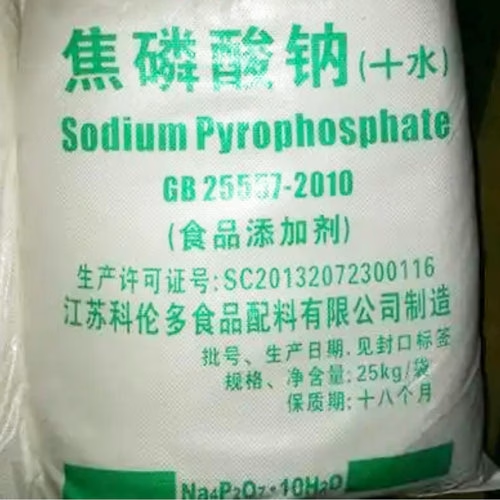I. Introduction of Sodium Pyrophosphate Decahydrate
Sodium pyrophosphate decahydrate is a crystalline solid with the chemical formula Na4P2O7·10H2O.Its crystalline form shows colorless hexagonal crystal system crystals, with high solubility.

CAS No.: 13472-36-1, EINECS No.: 231-767-1, Molecular Weight: 446.05
Density 1.82
Water solubility 62 g/L (20°C)
II. Sodium pyrophosphate decahydrate vs Sodium pyrophosphate
Sodium pyrophosphate decahydrate and sodium pyrophosphate anhydrous are both different forms of sodium pyrophosphate that exist, the main difference being their hydration state.
a. Chemical structure and physical properties
- Sodium pyrophosphate decahydrate is soluble in water and insoluble in ethanol. It is easily weathered in dry air, and will lose crystallization water when heated to 100℃. It can generate complexes with alkaline earth metal ions; when it meets with Ag+, it generates white silver pyrophosphate.
This form of sodium pyrophosphate contains ten water molecules, so it is white crystal at room temperature, soluble in water, with good stability and solubility. - Anhydrous sodium pyrophosphate, with the chemical formula Na4P2O7, is another form of sodium pyrophosphate that exists without water molecules. Sodium pyrophosphate anhydrous exhibits higher activity and stronger reactivity in chemical reactions, making it more useful in certain specific applications.

b. Applications
- sodium pyrophosphate decahydrate is mainly used in food additives, water treatment agents, detergents and other fields due to its hydrated state, good solubility and stability.
- Anhydrous sodium pyrophosphate is widely used in chemical synthesis, catalyst preparation, pharmaceutical synthesis and other fields due to its high activity and strong reaction performance.
III. Main production methods of sodium pyrophosphate decahydrate
a. High-temperature dehydration method:
Disodium hydrogen phosphate (Na2HPO4-12H2O) is heated at 115-130°C to remove the crystallization water to get anhydrous disodium hydrogen phosphate. Then the anhydrous disodium hydrogen phosphate is subjected to dehydration polymerization reaction at a high temperature of 450-550°C to produce sodium pyrophosphate. After the completion of the reaction, the product is cooled and put into the dissolution tank, add 80 ℃ hot water to dissolve, then cooled and crystallized, centrifugal separation, and finally get sodium pyrophosphate decahydrate.
b. Anhydrous sodium pyrophosphate method:
First neutralization reaction of phosphoric acid and soda ash to generate disodium hydrogen phosphate, after spray drying, then melt polymerization reaction, cooling to get anhydrous sodium pyrophosphate. Add anhydrous sodium pyrophosphate into the dissolving tank with water to dissolve, control the concentration of the solution after cooling and crystallization, centrifugal separation, to produce crystalline sodium pyrophosphate finished products.
IV. Packing and Storage of Sodium Pyrophosphate Decahydrate
a. Packaging
Packaging of Sodium Pyrophosphate Decahydrate usually consists of a polyethylene plastic bag lined with an outer plastic woven bag, with a weight of 25 kg per bag.

b. Storage conditions
- Temperature: should be stored in a dry, ventilated and clean warehouse at +5°C to +30°C.
- Humidity: It should be protected from moisture and heat, and avoid rain and moisture.
- Segregation: it should be stacked in isolation from toxic substances during storage

V. Conclusion
Sodium pyrophosphate usually exists in two forms, decahydrate and anhydrous, which are different due to their hydration states, and although they differ in their properties and applications, they are not particularly large. When you buy anhydrous sodium pyrophosphate than sodium pyrophosphate decahydrate, you should distinguish which one you need. In the use of anhydrous sodium pyrophosphate is a little broader. Food-grade sodium pyrophosphate is a common legal food additive in food; while industrial-grade sodium pyrophosphate is used in large quantities in water treatment, printing and dyeing, washing and other industries. The food grade sodium pyrophosphate supplied by WHWANZE is anhydrous sodium pyrophosphate, if you need food grade sodium pyrophosphate decahydrate, please contact us directly, and we will give you a quotation according to your specific needs.
Expanding reading:
Sodium acid pyrophosphate vs sodium pyrophosphate.

